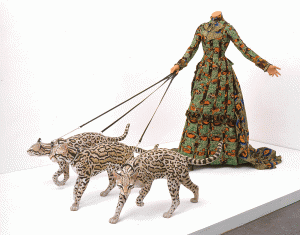« Reviews
Yinka Shonibare MBE

Yinka Shonibare, MBE (b. United Kingdom, 1962), Leisure Lady (with ocelots), 2001, Life-size fiberglass mannequin, three fiberglass ocelots, Dutch wax printed cotton, leather, glass, Dimensions variable; woman 63 x 31 1/2 x 31 1/2 in., ocelots each 15 3/4 x 23 1/2 x 7 7/8 in., Vanhaerents Art Collection, Brussels, Belgium, Image courtesy of the artist, Stephen Friedman Gallery, London, and James Cohan Gallery, New York, © the artist
Brooklyn Museum, New York
June 26 - September 20, 2009
By Janet Batet
Yinka Shonibare is undoubtedly one of the most relevant contemporary artists. His dramatic oeuvre, colorful installations recreating scenes from history and art, discusses top current issues such as identity, post colonialism, cross culture and trans-identity.
The Brooklyn Museum offers to us the delightful exhibition “Yinka Shonibare MBE,” a major mid-career survey of work by the Nigerian-born, British artist. MBE stands for Member of the Order of the British Empire, title awarded to Mr. Shonibare in 2005.
Shonibare has a vivid fascination with the Victorian period: the longest reign in British history and a sort of Belle Époque for the British Empire, characterized by a durable peace and economic, social and colonial consolidation. As a metaphoric reference, this period corresponds with the establishment of policies of the New Imperialism, based on doctrines of racial superiority that increased conflicts in the colonies, still alive today, and resulted in one of the first major migrations in the Empire: around 15 million emigrants left the United Kingdom and settled mostly in the United States, Canada and Australia. Having settled on this controversial counterpoint as a starting point for his oeuvre, Shonibare recreates a marvelous symphony, where the reference to art and history weaves an effective commentary on one of the most-pressing issues in our contemporary world: trans-identity.
His life-size headless mannequins wear attire of the most sophisticated Victorian style, paradoxically made of Adire, a very detailed, colorful African cloth based on a tie-dying technique. Always active participants in everyday life that the artist most of the time borrows from art history, Shonibare’s characters reveal the agonizing condition of a human being caught between two cultures. His work breathes a bipolar nature where the relationship between colony and metropolis, white and black, poor and rich, traditional and contemporary society modulates a new cultural individual.
Included in the present exhibition, Odile and Odette (2005) is symptomatic in this sense. This poetic, choreographic video presents two ballerinas, one black and one white, who embody the conflicting characters from Tchaikovsky’s “Swan Lake” through a baroque mirror. Playing with the paradox reality-reflex, the dramatic masterpiece emphasizes the contrast of polarities and stereotypes as artificial boundaries and preconceived expectations.
The Swing (after Fragonard) (2001) paraphrases the iconic Rococo painting by Jean-Honoré Fragonard, The Swing (Les hazards heureux de l’escarpolette) (1767). The installation summarizes the canvas with three sufficient elements: the indulgent aristocratic girl on the swing, the flying shoe as iconic attribute and the swing with some foliage. The distended and sensual recreation contrasts with the installation Gallantry and Criminal Conversation (2002), which fills a giant fourth-floor gallery and where sensuality and flirtation have been replaced by stark libido. The voyeuristic ensemble is composed of thirteen figures, who engage in copulation, adopting explicit sexual positions. The presence of the carriage and trunks imparts the idea of traveling and adultery, revealing a torrid nature, usually hidden behind the sophisticated costumes and courtly manners, once away from home.
Janet Batet: Independent art critic and curator. MA in Multimedia (UQAM University, Montreal); BA in Art History (University of Havana).
Filed Under: Reviews


































